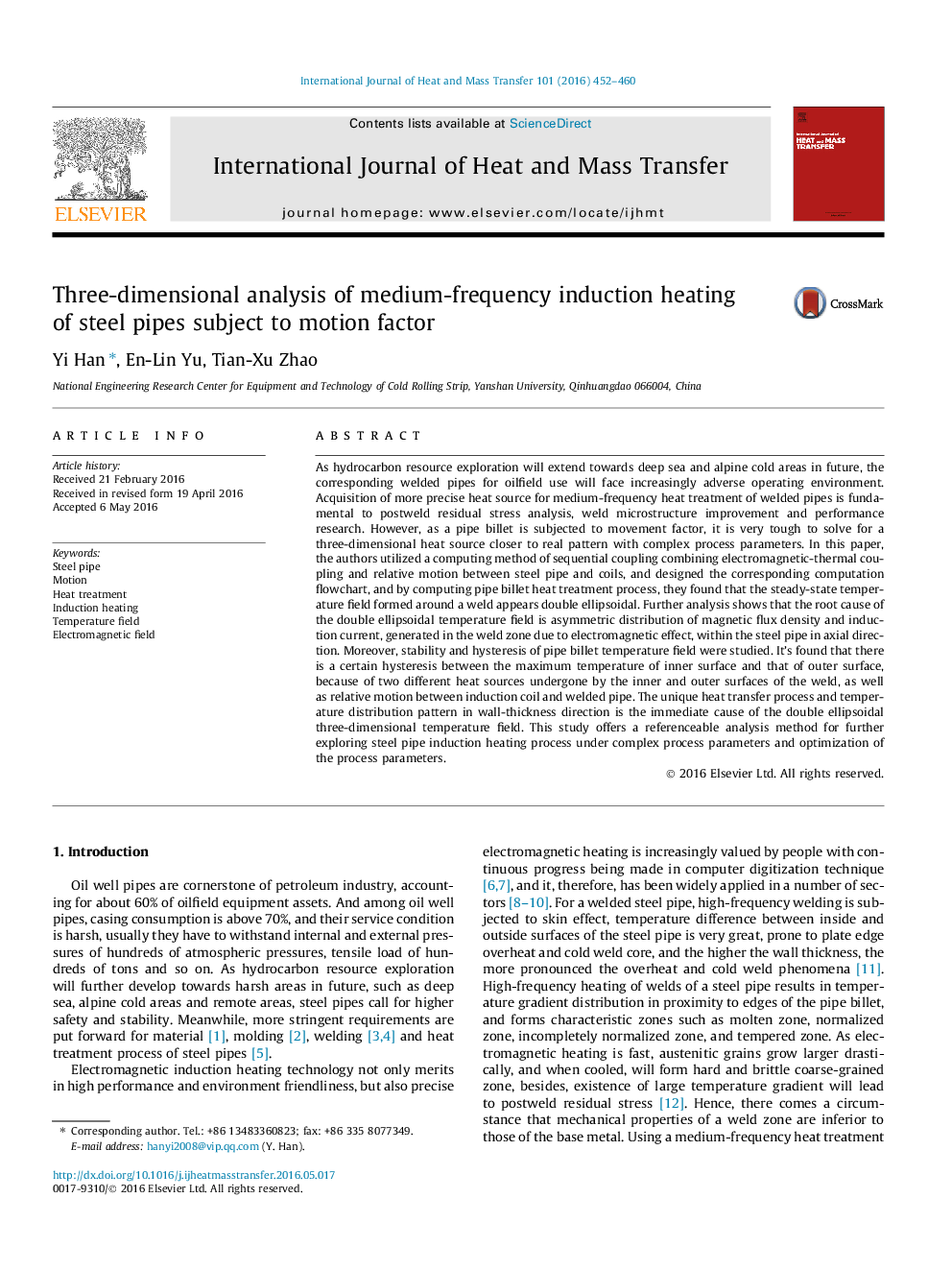| کد مقاله | کد نشریه | سال انتشار | مقاله انگلیسی | نسخه تمام متن |
|---|---|---|---|---|
| 7055277 | 1458041 | 2016 | 9 صفحه PDF | دانلود رایگان |
عنوان انگلیسی مقاله ISI
Three-dimensional analysis of medium-frequency induction heating of steel pipes subject to motion factor
ترجمه فارسی عنوان
تجزیه و تحلیل سه بعدی گرمایش القایی متوسط لوله های فولادی با توجه به عامل حرکت
دانلود مقاله + سفارش ترجمه
دانلود مقاله ISI انگلیسی
رایگان برای ایرانیان
کلمات کلیدی
لوله های فولادی، حرکت حرارت درمانی، گرمایش القایی، زمینه دما، میدان الکترومغناطیسی،
ترجمه چکیده
همانطور که اکتشاف منابع هیدروکربنی در آینده به سمت مناطق دریای عمیق و سرزمین های سرپوشیده گسترش می یابد، لوله های جوش داده شده مربوط به استفاده از میدان های نفتی به طور فزاینده محیط عملیاتی روبرو خواهند شد. به دست آوردن دقیق تر گرما برای حرارت حرارت متوسط لوله های جوش داده شده برای تجزیه و تحلیل استرس باقی مانده پس مانده، بهبود ریز ساختار جوش و تحقیقات عملکرد اساسی است. با این حال، به عنوان یک ضایعه لوله تحت عامل حرکت قرار می گیرد، برای یک منبع گرمای سه بعدی نزدیک به الگوی واقعی با پارامترهای فرایند پیچیده، بسیار سخت است. در این مقاله، نویسندگان روش محاسباتی ترکیبی پیوندی ترکیب جرم الکترومغناطیسی و حرارتی و حرکت نسبی بین لوله های فولادی و کویل ها را طراحی کرده اند و فلوچارت محاسبات مربوطه را طراحی کرده اند و با محاسبه فرآیند پردازش گرمادهی بطری لوله، آنها دریافتند که حالت پایدار دمای محیطی که در اطراف جوش تشکیل شده به نظر می رسد دوبعدی بیضوی. تجزیه و تحلیل های بیشتر نشان می دهد که علت ریشه ای از میدان دمای بیضوی دوگانه توزیع نامتقارن چگالی شار مغناطیسی و جریان القایی، تولید شده در منطقه جوش به علت اثر الکترومغناطیسی، در لوله فولادی در جهت محوری است. علاوه بر این، پایداری و هیسترزیزم میدان دمایی لوله مورد مطالعه قرار گرفت. یافته شده است که به دلیل دو منبع مختلف گرما که تحت پوشش سطوح داخلی و بیرونی جوش، و نیز حرکت نسبی بین سیم پیچ القاء شده و لوله جوش قرار گرفته است، رابطه ای بین دمای حداکثر سطح داخلی و سطح بیرونی وجود دارد. فرایند انتقال حرارت منحصر به فرد و الگوی توزیع دما در جهت ضخامت دیواره، علت فوری زمینه دمایی دو بعدی بیضوی است. این مطالعه یک روش تجزیه و تحلیل قابل توصیف برای بررسی بیشتر روند گرمایش القایی فولاد تحت پارامترهای فرایند پیچیده و بهینه سازی پارامترهای فرایند ارائه می دهد.
موضوعات مرتبط
مهندسی و علوم پایه
مهندسی شیمی
جریان سیال و فرایندهای انتقال
چکیده انگلیسی
As hydrocarbon resource exploration will extend towards deep sea and alpine cold areas in future, the corresponding welded pipes for oilfield use will face increasingly adverse operating environment. Acquisition of more precise heat source for medium-frequency heat treatment of welded pipes is fundamental to postweld residual stress analysis, weld microstructure improvement and performance research. However, as a pipe billet is subjected to movement factor, it is very tough to solve for a three-dimensional heat source closer to real pattern with complex process parameters. In this paper, the authors utilized a computing method of sequential coupling combining electromagnetic-thermal coupling and relative motion between steel pipe and coils, and designed the corresponding computation flowchart, and by computing pipe billet heat treatment process, they found that the steady-state temperature field formed around a weld appears double ellipsoidal. Further analysis shows that the root cause of the double ellipsoidal temperature field is asymmetric distribution of magnetic flux density and induction current, generated in the weld zone due to electromagnetic effect, within the steel pipe in axial direction. Moreover, stability and hysteresis of pipe billet temperature field were studied. It's found that there is a certain hysteresis between the maximum temperature of inner surface and that of outer surface, because of two different heat sources undergone by the inner and outer surfaces of the weld, as well as relative motion between induction coil and welded pipe. The unique heat transfer process and temperature distribution pattern in wall-thickness direction is the immediate cause of the double ellipsoidal three-dimensional temperature field. This study offers a referenceable analysis method for further exploring steel pipe induction heating process under complex process parameters and optimization of the process parameters.
ناشر
Database: Elsevier - ScienceDirect (ساینس دایرکت)
Journal: International Journal of Heat and Mass Transfer - Volume 101, October 2016, Pages 452-460
Journal: International Journal of Heat and Mass Transfer - Volume 101, October 2016, Pages 452-460
نویسندگان
Yi Han, En-Lin Yu, Tian-Xu Zhao,
